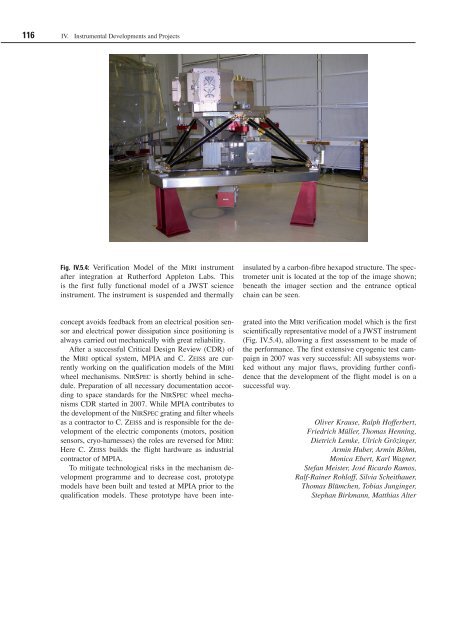Max Planck Institute for Astronomy - Annual Report 2007
Max Planck Institute for Astronomy - Annual Report 2007
Max Planck Institute for Astronomy - Annual Report 2007
Create successful ePaper yourself
Turn your PDF publications into a flip-book with our unique Google optimized e-Paper software.
116 IV. Instrumental Developments and Projects<br />
Fig. IV.5.4: Verification Model of the Miri instrument<br />
after integration at Ruther<strong>for</strong>d Appleton Labs. This<br />
is the first fully functional model of a JWST science<br />
instrument. The instrument is suspended and thermally<br />
concept avoids feedback from an electrical position sensor<br />
and electrical power dissipation since positioning is<br />
always carried out mechanically with great reliability.<br />
After a successful Critical Design Review (CDR) of<br />
the Miri optical system, MPIA and C. Zeiss are currently<br />
working on the qualification models of the Miri<br />
wheel mechanisms. Nirspec is shortly behind in schedule.<br />
Preparation of all necessary documentation according<br />
to space standards <strong>for</strong> the Nirspec wheel mechanisms<br />
CDR started in <strong>2007</strong>. While MPIA contributes to<br />
the development of the Nirspec grating and filter wheels<br />
as a contractor to C. Zeiss and is responsible <strong>for</strong> the development<br />
of the electric components (motors, position<br />
sensors, cryo-harnesses) the roles are reversed <strong>for</strong> Miri:<br />
Here C. Zeiss builds the flight hardware as industrial<br />
contractor of MPIA.<br />
To mitigate technological risks in the mechanism development<br />
programme and to decrease cost, prototype<br />
models have been built and tested at MPIA prior to the<br />
qualification models. These prototype have been inte-<br />
insulated by a carbon-fibre hexapod structure. The spectrometer<br />
unit is located at the top of the image shown;<br />
beneath the imager section and the entrance optical<br />
chain can be seen.<br />
grated into the Miri verification model which is the first<br />
scientifically representative model of a JWST instrument<br />
(Fig. IV.5.4), allowing a first assessment to be made of<br />
the per<strong>for</strong>mance. The first extensive cryogenic test campaign<br />
in <strong>2007</strong> was very successful: All subsystems worked<br />
without any major flaws, providing further confidence<br />
that the development of the flight model is on a<br />
successful way.<br />
Oliver Krause, Ralph Hofferbert,<br />
Friedrich Müller, Thomas Henning,<br />
Dietrich Lemke, Ulrich Grözinger,<br />
Armin Huber, Armin Böhm,<br />
Monica Ebert, Karl Wagner,<br />
Stefan Meister, José Ricardo Ramos,<br />
Ralf-Rainer Rohloff, Silvia Scheithauer,<br />
Thomas Blümchen, Tobias Junginger,<br />
Stephan Birkmann, Matthias Alter

















